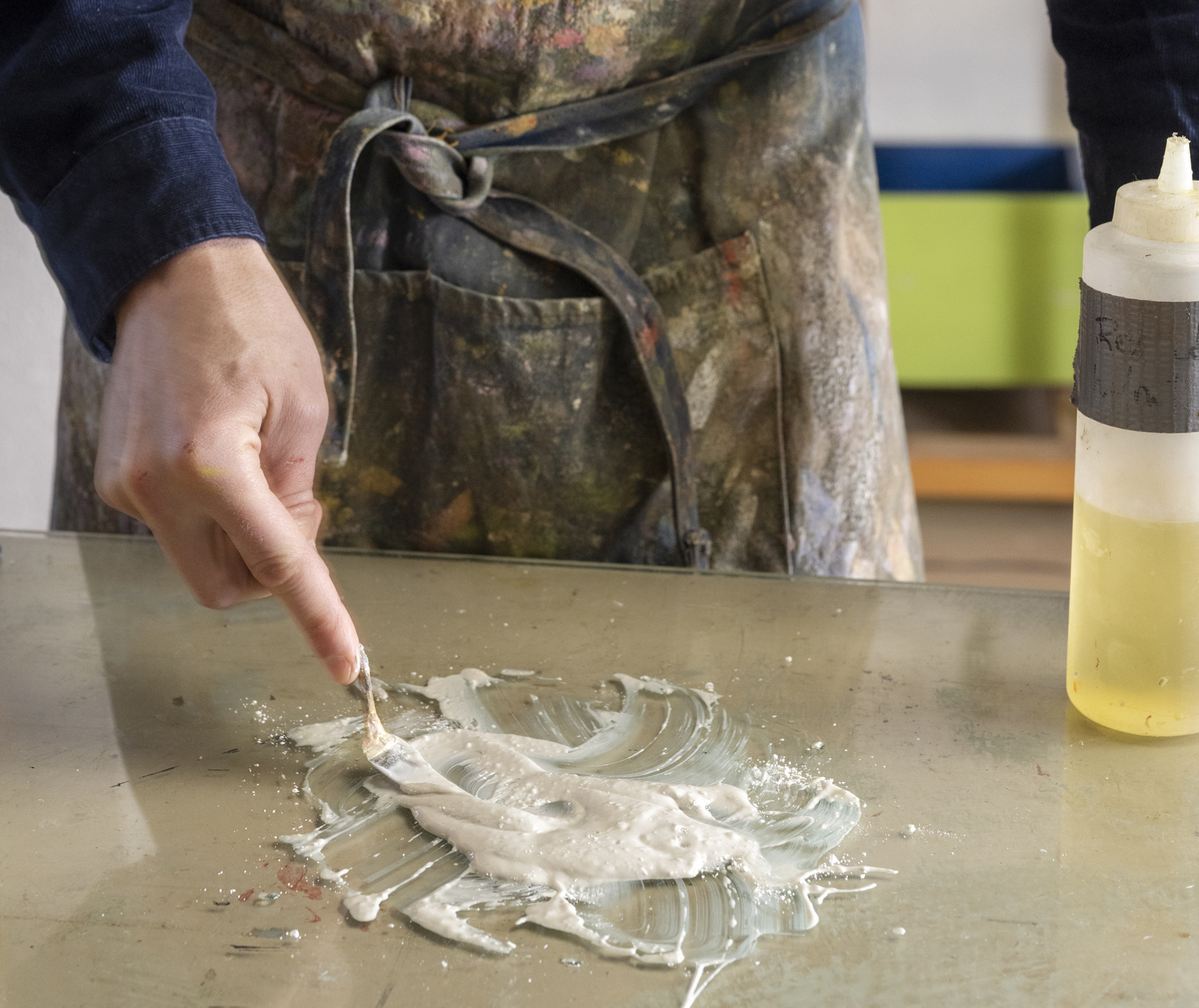Painter’s Toxicity: Part 1
by David Molesky // Photo by Ben Alper

Molesky mixing a putty medium in his studio in NC.
I’ve been meaning to write about the toxicity and dangers encountered by painters especially those who have an everyday practice. In this first section I tell the narrative of my identification of the problem.
—————————
When I was young and still in my first few years of painting, I was told by my high school teacher and a few of my college professors that there are two paths for someone like me who is dedicated to painting: you can live fast and die young or you can go for the long road. Obviously I chose the long road because who really wants to live a short life anyway.
After working with Odd Nerdrum from 2006-2008, where I had a seperate studio from my sleeping quarters, I moved into a tiny commercial space on Market street in San Francisco. Here I lived a truly bohemian life, working and sleeping in 240 sq. ft (22 sq. meters) amongst my paintings for 4 years. For much of my life, I have painted in the same space where I sleep.
When I began painting in oils in 1993, I was completely unaware of the toxic effects that the oil painting could have on my health. I thought the way to thin oil paint was turpentine, much in the same way you thin acrylics with water. With further education, I learned that you could make mediums with linseed oil. In college, teachers introduced ready made mediums such as galkyd and liquin. Instead of grad school, I apprenticed with a couple “New Old Masters” who all advised me to make my own medium using a mixture of ½ linseed oil with 1/2 turpentine.
It wasn’t until I was living and working in my tiny warehouse room in San Francisco that I really got to thinking about how these materials could affect my health. I discovered that it is possible to improve upon the standard approach to oil painting taught to me by others. It started when a high school painting friend noticed during a studio visit that I liked painting in a buttery manner and suggested that I might enjoy using walnut oil. He mentioned the drying time was a little slower than linseed oil and that I wouldn’t need to cut it with a solvent (like you do with linseed oil) to use it as a medium. So, I purchased some at an art store. It only came in tiny bottles and did not seem like a popular product.
These two small bottles of walnut oil soon ran out after a month or so. During that time, my studio and home were solvent free. I still had quite a large stash of the mediums I was using before so I thought, “well, that was a nice experiment with walnut oil, I’ll just go back to using linseed oil and odorless mineral spirits again.” Having acclimated to painting without solvents for the first time in 17 years, it became clear how they affected me when I began using them again.
One thing I noticed immediately was the feeling of a mild inflammation in my lungs, which in turn resulted in a mild inflammation in my brain and noticeable increased difficulty in my ability to focus. But it quickly became apparent that the solvents were also affecting my skin. In the hand where I usually hold my painting rag, the skin between my finger nail and my first knuckle began peeling off. I started wearing gloves and worked with a contractor to install a powerful ventilation fan that was rated as having the capacity to empty the entire space’s air every three minutes. I even followed the design guidelines suggested by Mark David Gottsegen’s “The Painter’s Handbook,” which to my knowledge is the only mainstream book of its kind that has anything to say about the dangers of solvents.
Even with all of these precautions, I still didn’t feel as well as I did when solvents were absent from my space. I thought about the two artists that I read about in college whose chosen materials lead to an early death: Eva Hesse whose use of resin lead caused a deadly brain tumor and Jay DeFeo whose use of lead paint gave her lung cancer. These artists in some ways were the martyrs that brought more mainstream attention to the potentially lethal dangers of materials.
A decade after graduating, I realized that the very teachers who spoke about the toxicity of these more exotic art materials, were severely risking their lives with the most basic studio materials. In a horror stricken moment, I counted the six painters that I identified as my teachers, all but one suffered serious health issues that very well could be attributed to the use of materials. Three had suffered strokes and one died of brain cancer all in their 60’s. The only oil painter who did not suffer a terrible fate paints exclusively outdoors en plein air.
The mentor who I was most closely working with at the time of this realization was beginning to have bouts of pneumonia with increasing frequency. I thought back to the first time I visited his studio and how I was blown away by the strong smell of the English distilled turpentine and liquin and accompanying rags laying about on the table. I commented on this and he said that it was fine because with his 20 foot high ceilings the vapors would disperse. Although my intuition highly doubted this, I did not want to argue with someone who I was asking for mentorship.
After my experience working solvent free, I realized that solvents were ruining the health of most of the older full time painters that I knew. I set to work to find a solution so that I could prevent myself and friends from becoming another health statistic.
